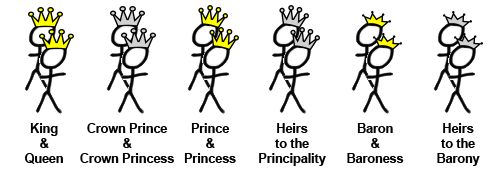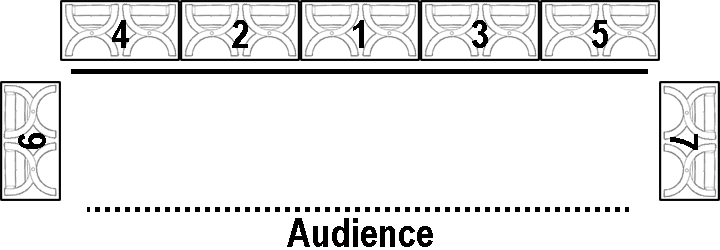One of the duties of a protocol herald is the successful arrangement of thrones for court. There are several opinions about how this should be done, and customs differ from kingdom to kingdom. In this article, I will describe my own logic and structure in the arrangement of royalty and nobility for court, from the simplest one-throne setup to the daunting interkingdom Grand Court.
I will note that this system is my own, utilized during my tenure as Crescent Principal Herald, and is based on over a decade of experience running courts in the SCA and an educated understanding of the rules of courtoisie in the Middle Ages.
Who’s Coming to Dinner?
The first step in arranging court is to find out: who’s sitting at court? If the answer is “the King” or “the Queen,” your job is done. Set up the single throne in the center of the dais, arrange the court around it, and call it a day.
However, you are far more likely to have couples sitting court, and if you have more than one pair, they will likely be of different ranks. Get a list of those who intend to sit court from the event steward, chamberlain, Royal liaison, or whomever would have the information for court. Having their names is useful for the court herald, but for the purposes of arranging the dais only the titles and territories are necessary.
Know Your Precedence
Now that you have a list of everyone who should be seated on the dais, your next step is to put them in precedence order. I describe this at some length in my article on how precedence works, but generally, precedence for court is decided by the crowning or investiture of the first heads of the territory, grouped as follows:
- Kings and Queens
- Heirs to Kingdoms
- Territorial Princes and Princesses
- Heirs to Principalities
- Territorial Barons and Baronesses
- Heirs to Territorial Barons and Baronesses by order of kingdom, then barony, founding
- Former rulers of a territory, by territorial precedence order as above, then chronologically by reign.*
*This is done only in rare circumstances, such as a baronial anniversary for a barony that has the tradition of seating former territorial barons and baronesses.

Information on the order of precedence for each territory may be found elsewhere on this website.
Within its own lands each territory takes top precedence among its class. For example, at an event held in the Barony of Lion’s Gate in the Principality of Tir Righ within the Kingdom of An Tir, the King of An Tir outranks the King of the West, the Prince of Tir Righ outranks the Princes of the Mists (West) and the Summits (An Tir), and the Baron of Lion’s Gate outranks all other territorial barons.
Once you have arranged the nobility by their general precedence order, determine who is the host of the court. The host of the court jumps to the very head of the precedence order, because it is Their court.
- At an event run by the Barony of the Angels where there will be baronial business, and Their Majesties of Caid are in attendance but bring no court business other than perhaps a presentation, Their Excellencies of the Angels are the hosts of the court.
- At a Sun Dragon baronial investiture where Their Majesties of Atenveldt intend to conduct Their own business including a transition of power from one baronial couple to another, Their Majesties of Atenveldt are the hosts of the court.
- At a war between the Kingdoms of An Tir and the West, held within the borders of An Tir, Their Majesties of An Tir are the hosts of the court.
- At an inter-kingdom war between the East and Middle, held in the Kingdom of Æthelmearc, Their Majesties of Æthelmearc are the hosts of the court.
For some courts, there are principal players who are not hosts of the court but are of primary importance to it. In the previous examples, Their Majesties of Caid are principal players of the Angels event (as the Baron and Baroness are in fief to them), the Barons and Baronesses (outgoing and incoming) of Sun Dragon are principal players at their own investiture, Their Majesties of the West are principal players at the West-An Tir war, and Their Majesties of the East and Middle are principal players of Pennsic War. Because of their status and importance to the event, the principal players move up in the precedence list to just behind the hosts.
Be aware the politics of deciding who is a host and who is a principal. If the event is being held jointly between two baronies in the same kingdom, and Their Majesties of that kingdom are seated at court, it is generally better to seat Their Majesties as hosts to both Their vassals, rather than seating them equally with the non-host Baronial pair.
Take Your Partner…
In the next section, we will place the couples on the dais based on the order of precedence set. Each rank and territory is seated as a unit; a royal/principal/baronial pair should not be split up. When seated, the throne of a consort/baroness should be to the sovereign/baron’s left, which is the audience’s right.
Place the first couple in the center of the dais, then place the second couple to the audience’s left of the first couple (if there are an even number of couples, you might consider recentering the thrones). This place is the seat of honor, at the right-hand side of the king.

Place the third couple to the audience’s right of the first couple. 
Continue to place couples to the audience’s left and right of the couples already seated…

Until all couples are seated on the dais.

Logic Does Not Always Prevail
So this structure works great, when there are pairs for each set. But what happens when stations 2 and 4 have only one person?

At a certain point, the logic of precedence order must give way to the aesthetic of stagecraft. It makes more sense visually for there to be a balance in the number of thrones on either side of the stage. Switching stations 4 and 5 fixes the balance of the stage with the least amount of fuss or perception of disrespect.

Aesthetically, it is good for groups on opposite ends of a war to sit on opposite ends of the stage. So what happens when placement of couples into stations splits up Royals and their Heirs, or puts the heads of territories on opposite ends of the war next to each other? Take for example this hypothetical situation, where Caid is hosting a war between the West and Atenveldt, and each set of monarchs has a Crown Prince and Princess in attendance. The technical and proper layout is this:

This one is a bit trickier, depending on which side of the War Caid is on. If Caid and the West are allied, swapping the Princes and Princesses of The West and Atenveldt, the Heirs are placed with or near Their respective Monarchs, and the Kings and Queens are largely untouched.

But if Caid is allied with Atenveldt, the situation gets more difficult. The fastest way to place the Kings and Queens with Their Heirs is to swap positions 2 and 3, moving the Western Royals to the audience’s right and the Aten Royals to the audience’s left. However, this places Atenveldt into a greater position than the West, both in precedence and in visual prestige. For anyone who’s had to deal with the West in matters of protocol, this Just Won’t Dotm.

The third option, placing all of the Crowns with their Heirs as single units and placing the kingdoms in order of precedence, is even worse, because it relegates both sets of visiting Monarchs to a station below the Crown Prince and Crown Princess of Caid, an unhappy way to treat honored guests. It also furthers the placement of Atenveldt’s Crown above the West’s.

So what do you do? Recognize that the decision to change the layout lies beyond your pay grade. Plan to set the dais up initially using the standard configuration, and advise all three sets of Crowns of the issue and possible resolutions. If the Royalty are able to agree on any of the alternative layouts, change the layout before court. Experienced Crowns tend to be cognizant of both propriety and aesthetics, and will usually settle on the right decision. In any event, if the Royalty support the layout of the dais, they will quickly silence those who take offense.
This Stage Isn’t Big Enough for the Twenty of Us!
Most courts are small, with a maximum of three seated couples. However, when dealing with wars and other inter-kingdom events, there may be more thrones than can fit on the dais. While there are some ways of arranging the thrones so that more can fit in the available space (e.g. placing them in a deep arc rather than in a straight line) at some point the decision must be made not to seat some couples on the dais.
In order to avoid offense, if one couple is removed from the lineup, all other couples in the same rank should likewise be removed (e.g. if there is only space for two out of the three sets of Territorial Princes and Princesses, none of them should be seated on the dais) unless one of those couples is the host or principal player. These displaced couples can still be honored, however. If there is space, consider setting their thrones perpendicular to the dais, in the space between the dais and the audience.

Otherwise, consider seating them in the front row, next to the aisle. If their thrones are likely to obscure the view of the rest of the audience, the displaced couples should probably be seated in regular (comfortable) chairs.
While on the topic of space, be sure to leave a gap next to each throne on the dais for the heralds to stand, and sufficient room behind each throne for the members of court and guard to move freely.
Conclusion
Staging a court is a thankless job. Many members of the populace, especially those who measure their participation in the SCA in decades rather than years, have strong opinions about the proper placement of thrones. These people will take offense on behalf of any Royal that they feel has been slighted. However, if you follow a logical and respectful pattern of placing the thrones, and have the support of those on stage for any aberration from that pattern, you should have no problem from these detractors.